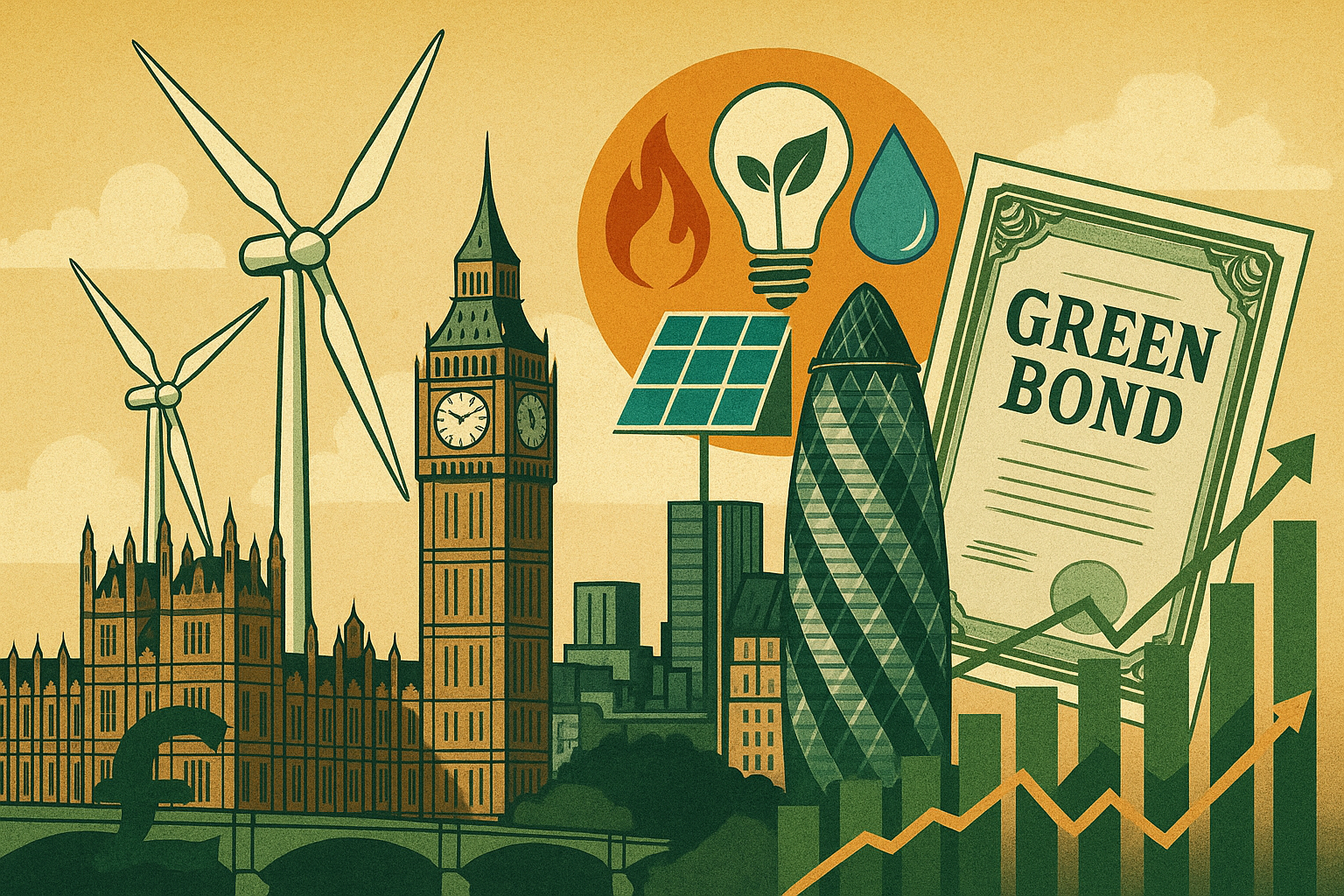The United Kingdom was one of the first major economies to set a legally binding target of achieving net-zero carbon emissions by 2050. The goal is ambitious, the moral imperative clear. Yet, as the race to decarbonise gathers pace, one crucial question continues to haunt policymakers, investors, and businesses alike: who will pay for it?
As inflation pressures budgets, and global competition for clean-tech investment intensifies, Britain’s green transition depends not only on innovation and regulation but on the ability to mobilise vast sums of capital — public, private, and institutional — to transform its economy from fossil-fuel dependence to sustainable growth.
The Scale of the Challenge
Decarbonising the UK economy will require between £50 billion and £70 billion in investment annually for the next 25 years, according to the Climate Change Committee (CCC). That’s equivalent to building the entire Crossrail project — every year.
From renewable energy and electric vehicle (EV) infrastructure to carbon capture, hydrogen, and sustainable housing, the costs are staggering. Yet the potential rewards — in jobs, exports, and global competitiveness — are equally vast.
“The green transition is the biggest economic transformation since the Industrial Revolution,” says Dr. Caroline Hughes, senior researcher at the Institute for Public Policy Research (IPPR). “The question is not whether we can afford to finance it, but whether we can afford not to.”
Government Policy: Ambition Meets Austerity
The UK’s green financing framework has evolved steadily over the past decade. The Green Finance Strategy, launched in 2019 and updated in 2023, aims to align private capital flows with net-zero goals. The government has issued £30 billion in green gilts, making Britain the world’s third-largest sovereign green bond issuer after Germany and France.
But the pace of public investment has slowed amid fiscal tightening. The Treasury’s capital budgets remain constrained, and the cancellation of key projects — such as the northern leg of HS2 — has raised doubts about long-term infrastructure commitment.
Critics argue that policy inconsistency and regulatory uncertainty are deterring private investors. The UK Infrastructure Bank, launched in 2021 with a £22 billion mandate, has been praised for catalysing investment but criticised for moving too cautiously.
“Investors crave clarity and stability,” says Martin Ellison, managing director at London-based renewable investment firm GreenEdge Capital. “If energy policy shifts every election cycle, capital will simply go elsewhere — to the U.S. or EU, where incentives are clearer.”
Global Competition and the Investment Gap
The global race to finance the net-zero economy has accelerated since the U.S. introduced the Inflation Reduction Act (IRA) in 2022. With subsidies worth over $370 billion, the IRA has turbocharged clean-energy investment, attracting companies from around the world.
The European Union’s response — the Green Deal Industrial Plan — has loosened state-aid rules and pledged hundreds of billions in green-transition funding. By contrast, Britain’s approach remains modest in scale and fragmented.
A 2024 report by the Energy and Climate Intelligence Unit estimated that the UK is investing roughly £25 billion less per year in green industries than it needs to stay on track for net zero. The result: growing concern that Britain could fall behind in the emerging global green economy.
“Capital flows to certainty,” explains Professor Andrew Kershaw, an economist at the University of Bath. “The U.S. and EU have created predictable frameworks. The UK must do the same if it wants to remain competitive.”
The Role of Private Finance
With public budgets strained, private capital will shoulder most of the burden. The City of London, long a global financial hub, is positioning itself as the world’s leading centre for green finance — using its deep pools of investment to accelerate decarbonisation.
Asset managers such as Aviva Investors, Legal & General, and Schroders are integrating climate criteria into their portfolios. Meanwhile, London Stock Exchange Group (LSEG) has launched its Voluntary Carbon Market initiative to boost transparency in carbon trading.
Banks are also playing a critical role. HSBC has pledged to provide up to $1 trillion in sustainable financing by 2030. Barclays has set a target of £100 billion by 2030, while Lloyds and NatWest have created specialist “green lending” divisions for renewable and energy-efficiency projects.
However, environmental campaigners accuse banks of “greenwashing” — financing renewables while continuing to fund fossil-fuel projects. The Bank of England, for its part, is under pressure to ensure financial regulation supports climate risk disclosure and transition alignment.
Innovations in Green Finance
Beyond traditional debt and equity markets, new financial mechanisms are emerging to fund Britain’s green future:
-
Green bonds — both sovereign and corporate — are becoming mainstream. As of 2025, UK green bond issuance surpassed £70 billion.
-
Sustainability-linked loans tie interest rates to measurable climate targets, incentivising emissions cuts.
-
Crowdfunding platforms now allow communities to co-invest in local solar farms or wind projects.
-
Green mortgages offer better rates for energy-efficient homes, supported by government-backed guarantee schemes.
“Finance is evolving as fast as technology,” says Sophie Lang, head of sustainability research at PwC. “Capital markets are learning to reward decarbonisation, not just profits.”
The Corporate Pivot
British corporates are also adapting to the financial realities of net zero. Major utilities like National Grid and ScottishPower are investing billions in transmission upgrades to handle renewables. Oil giants BP and Shell have pivoted toward wind, hydrogen, and EV charging, though their pace of transition remains controversial.
Meanwhile, the property and construction sectors — responsible for 25% of UK emissions — face pressure to retrofit millions of buildings for energy efficiency. Developers are issuing green REITs (real estate investment trusts) and using sustainability-linked financing to fund upgrades.
For small and medium-sized enterprises (SMEs), access to finance remains a challenge. Surveys by the British Business Bank show that many SMEs want to decarbonise but struggle with the upfront costs and limited awareness of green funding options.
Regional and Social Dimensions
The green transition also has a regional component. The government’s “Green Industries Growth Accelerator,” launched in 2024, targets industrial heartlands in the North East, Humber, and Teesside — regions hit hardest by industrial decline.
If managed well, the transition could create hundreds of thousands of jobs in renewables, EV manufacturing, and sustainable construction. If mishandled, it could deepen existing inequalities between prosperous southern regions and struggling northern communities.
“Net zero must be a just transition,” insists Dr. Hughes. “It’s not just about carbon — it’s about creating good jobs and opportunities across all parts of the UK.”
Public Attitudes and Political Will
Public support for climate action remains strong but not unconditional. Rising energy bills and living costs have fuelled scepticism about who bears the cost of decarbonisation. Opposition politicians have accused the government of “climate retreat” after delays to EV targets and home heating mandates.
Yet business leaders warn that delaying investment will cost more in the long run. Every year of inaction locks in high-carbon infrastructure and forfeits potential growth in green industries.
“Decarbonisation is an investment, not an expense,” says Ellison of GreenEdge Capital. “It creates resilience, efficiency, and competitiveness. The countries that act now will dominate the clean economy of tomorrow.”
Turning Vision into Capital
Britain’s green transition is not a matter of technology or ambition — both are abundant. It is a matter of finance and policy coherence. Unlocking the trillions needed to transform the economy will require bold leadership, consistent incentives, and long-term confidence for investors.
If the UK can strike that balance — aligning markets, regulation, and innovation — it could not only meet its climate goals but also revive its global economic influence in a new, low-carbon age.
The challenge, as ever, lies not in setting targets but in funding them.
700 701 702 703 704 705 706 707 708 709 710 711 712 713 714 715 716 717 718 719 720 721 722 723 724 725 726 727 728 729 730 731 732 733 734 735 736 737 738 739 740 741 742 743 744 745 746 747 748 749 750 751 752 753 754 755 756 757 758 759 760 761 762 763 764 765 766 767 768 769 770 771 772 773 774 775 776 777 778 779 780 781 782 783 784 785 786 787 788 789 790 791 792 793 794 795 796 797 798 799 800 801 802 803 804 805 806 807 808 809 810 811 812 813 814 815 816 817 818 819 820 821 822



